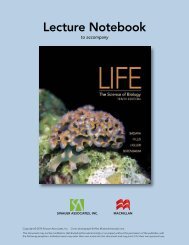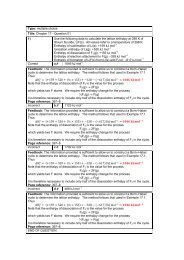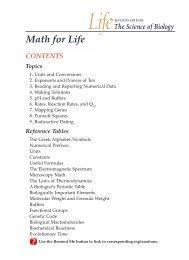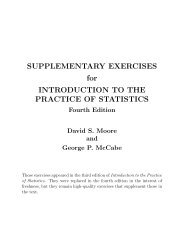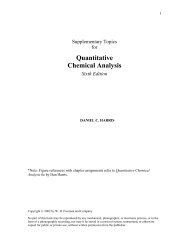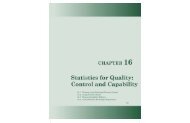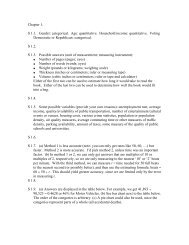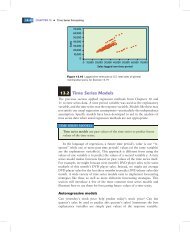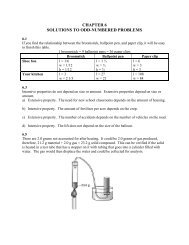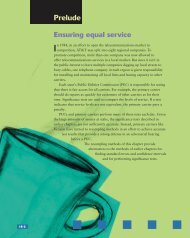Chapter 3 - Experimental Error - WH Freeman
Chapter 3 - Experimental Error - WH Freeman
Chapter 3 - Experimental Error - WH Freeman
You also want an ePaper? Increase the reach of your titles
YUMPU automatically turns print PDFs into web optimized ePapers that Google loves.
60 3 <strong>Experimental</strong> <strong>Error</strong><br />
Cheryl Cynthia Carmen Chastity Figure for Problem 3-12.<br />
3-12. Cheryl, Cynthia, Carmen, and Chastity shot the targets<br />
above at Girl Scout camp. Match each target with the proper<br />
description.<br />
(a) accurate and precise (c) precise but not accurate<br />
(b) accurate but not precise (d) neither precise nor accurate<br />
3-13. Rewrite the number 3.123 56 (0.167 89%) in the forms<br />
(a) number ( absolute uncertainty) and (b) number ( percent<br />
relative uncertainty) with an appropriate number of digits.<br />
Propagation of Uncertainty<br />
3-14. Find the absolute and percent relative uncertainty and<br />
express each answer with a reasonable number of significant<br />
figures.<br />
(a) 6.2 (0.2) 4.1 (0.1) ?<br />
(b) 9.43 (0.05) 0.016 (0.001) ?<br />
(c) [6.2 (0.2) 4.1 (0.1)] 9.43 (0.05) ?<br />
(d) 9.43 (0.05) {[6.2 (0.2) 10 3 ] <br />
[4.1 (0.1) 10 3 ]} ?<br />
3-15. Find the absolute and percent relative uncertainty and<br />
express each answer with a reasonable number of significant<br />
figures.<br />
(a) 9.23 (0.03) 4.21 (0.02) 3.26 (0.06) ?<br />
(b) 91.3 (1.0) 40.3 (0.2) / 21.1 (0.2) ?<br />
(c) [4.97 (0.05) 1.86 (0.01)] / 21.1 (0.2) ?<br />
(d) 2.016 4 (0.000 8) 1.233 (0.002) 4.61 (0.01) ?<br />
(e) 2.016 4 (0.000 8) 10 3 1.233 (0.002) 10 2 <br />
4.61 (0.01) 10 1 ?<br />
(f) [3.14 (0.05)] 1/3 ?<br />
(g) log[3.14 (0.05)] ?<br />
3-16. Verify the following calculations:<br />
(a) 23.141 5 (0.001 1) 1.772 4 3 (0.000 3 1 )<br />
(b) log[3.141 5 (0.001 1)] 0.497 1 4 (0.000 1 5 )<br />
(c) antilog[3.141 5 (0.001 1)] 1.385 2 (0.003 5 ) 10 3<br />
(d) ln[3.141 5 (0.001 1)] 1.144 7 0 (0.000 3 5 )<br />
20.104 (0.006)<br />
(e) loga 0.80 0 (0.01 5 )<br />
0.051 1 (0.000 9) b<br />
3-17. When using Class 1 standard weights (Table 2-1) to calibrate<br />
your balance, you want to place exactly 1 g on the balance.<br />
Is it more accurate to use a single 1-g weight or the combination<br />
500 mg 200 mg 200 mg 100 mg? Compare<br />
the uncertainties in mass for the two choices.<br />
3-18. Express the molecular mass (uncertainty) of<br />
C 9 H 9 O 6 N 3 with the correct number of significant figures.<br />
3-19. (a) Show that the formula mass of NaCl is 58.442 5<br />
(0.000 9) g/mol.<br />
(b) To prepare a solution of NaCl, you weigh out<br />
2.634 (0.002) g and dissolve it in a volumetric flask whose volume<br />
is 100.00 (0.08) mL. Express the molarity of the solution,<br />
along with its uncertainty, with an appropriate number of digits.<br />
3-20. What is the true mass of water weighed at 24°C in the air<br />
if the apparent mass is 1.034 6 0.000 2 g? The density of air<br />
is 0.001 2 0.000 1 g/mL and the density of balance weights<br />
is 8.0 0.5 g/mL. The uncertainty in the density of water in<br />
Table 2-7 is negligible in comparison to the uncertainty in the<br />
density of air.<br />
3-21. Twelve dietary iron tables were analyzed by the gravimetric<br />
procedure in Section 1-4 and the final mass of Fe 2 O 3<br />
(FM 159.688) was 0.277 4 0.001 8 g. Find the average mass<br />
of Fe per tablet. (Relative uncertainties in atomic masses are<br />
small compared with relative uncertainty in the mass of Fe 2 O 3 .<br />
Neglect uncertainties in atomic masses in this problem.)<br />
3-22. We can measure the concentration of HCl solution (a procedure<br />
called standardizing the solution) by reaction with pure<br />
sodium carbonate: 2H Na 2 CO 3<br />
B 2Na H 2 O CO 2 .<br />
A volume of 27.35 0.04 mL of HCl solution was required<br />
for complete reaction with 0.967 4 0.000 9 g of Na 2 CO 3<br />
(FM 105.988 0.001). Find the molarity of the HCl and its<br />
absolute uncertainty.<br />
3-23. Avogadro’s number can be computed from the following<br />
measurable quantities for a particular element: 2 (1) the atomic<br />
mass of the element (obtained from the mass and abundance of<br />
each isotope), (2) the density of a crystal of the element, (3)<br />
the size of the unit cell (the smallest repeating structural unit)<br />
in the crystal, and (4) the number of atoms in the unit cell.<br />
Extremely accurate measurements for silicon give an atomic<br />
mass of m Si 28.085 384 2 (35) g/mol, where 35 is the<br />
standard deviation in the last two digits. The density is <br />
2.329 031 9 (18) g/cm 3 , the size of the cubic unit cell is c 0 <br />
5.431 020 36 (33) 10 8 cm, and there are 8 atoms per unit<br />
cell. Avogadro’s number is computed from the equation<br />
N A <br />
m Si<br />
(ρc 03 )>8<br />
From the measured properties and their uncertainties (standard<br />
deviations), compute Avogadro’s number and its uncertainty. To<br />
find the uncertainty of c 03 , use the function y x a in Table 3-1.



